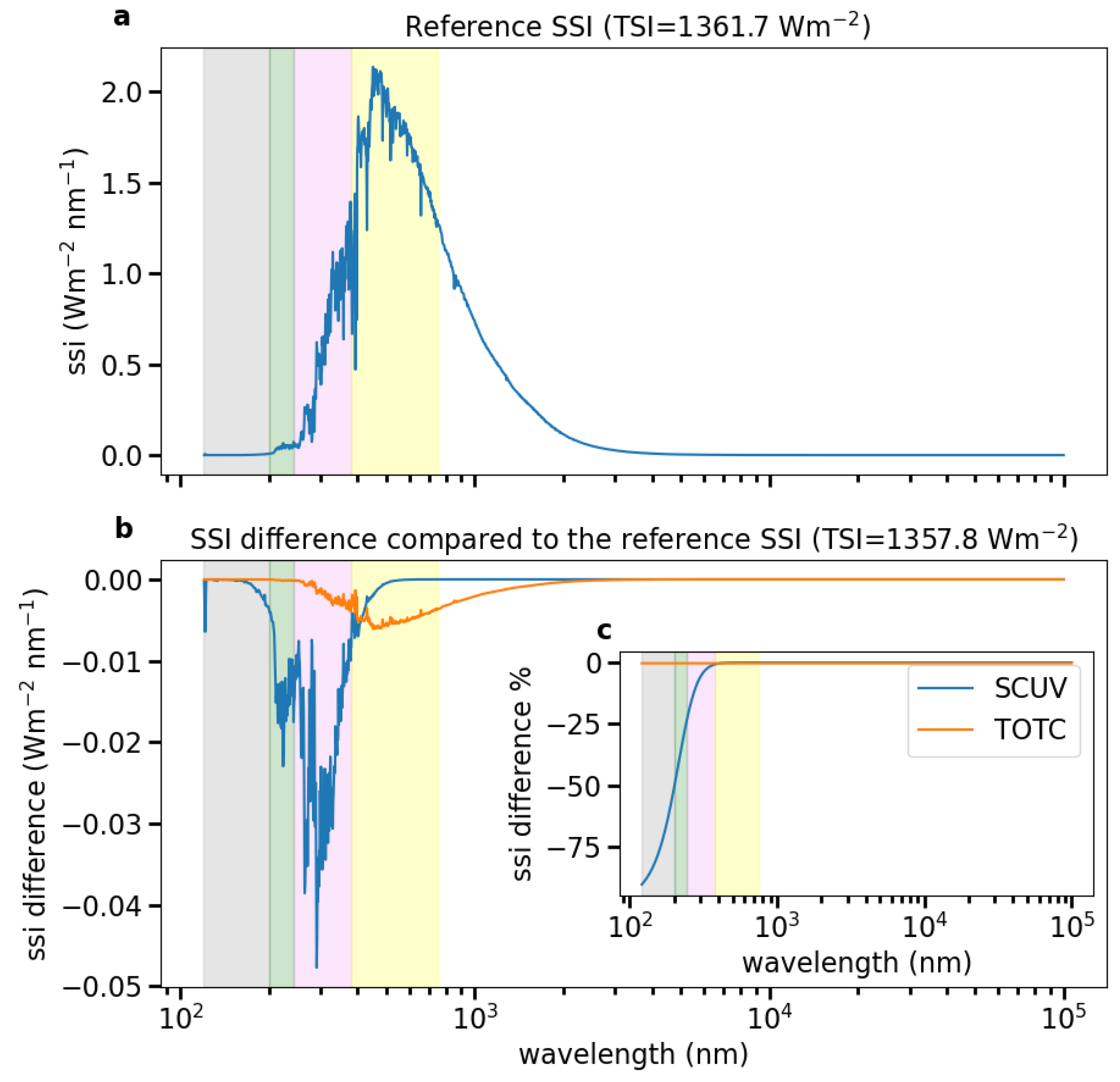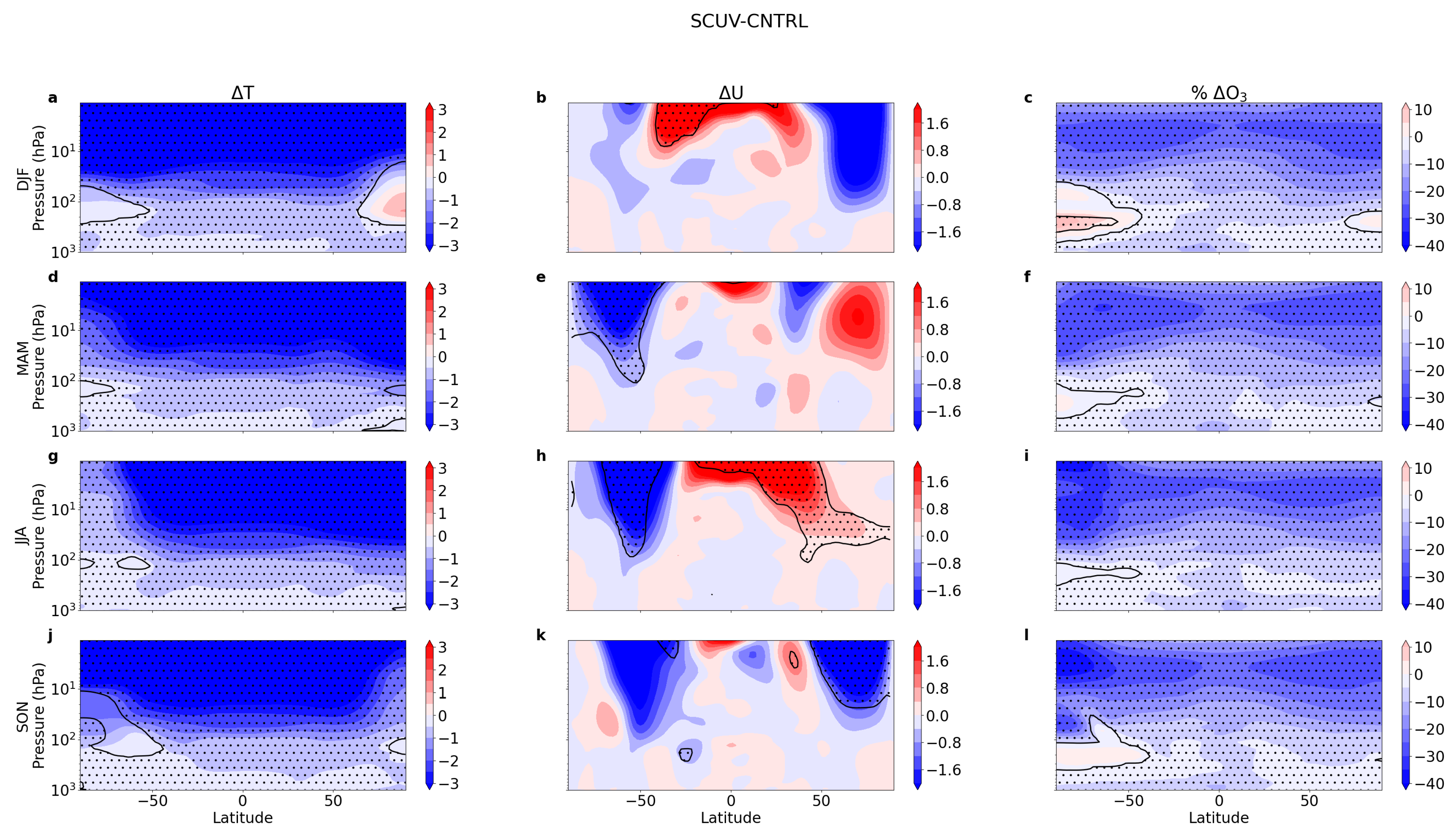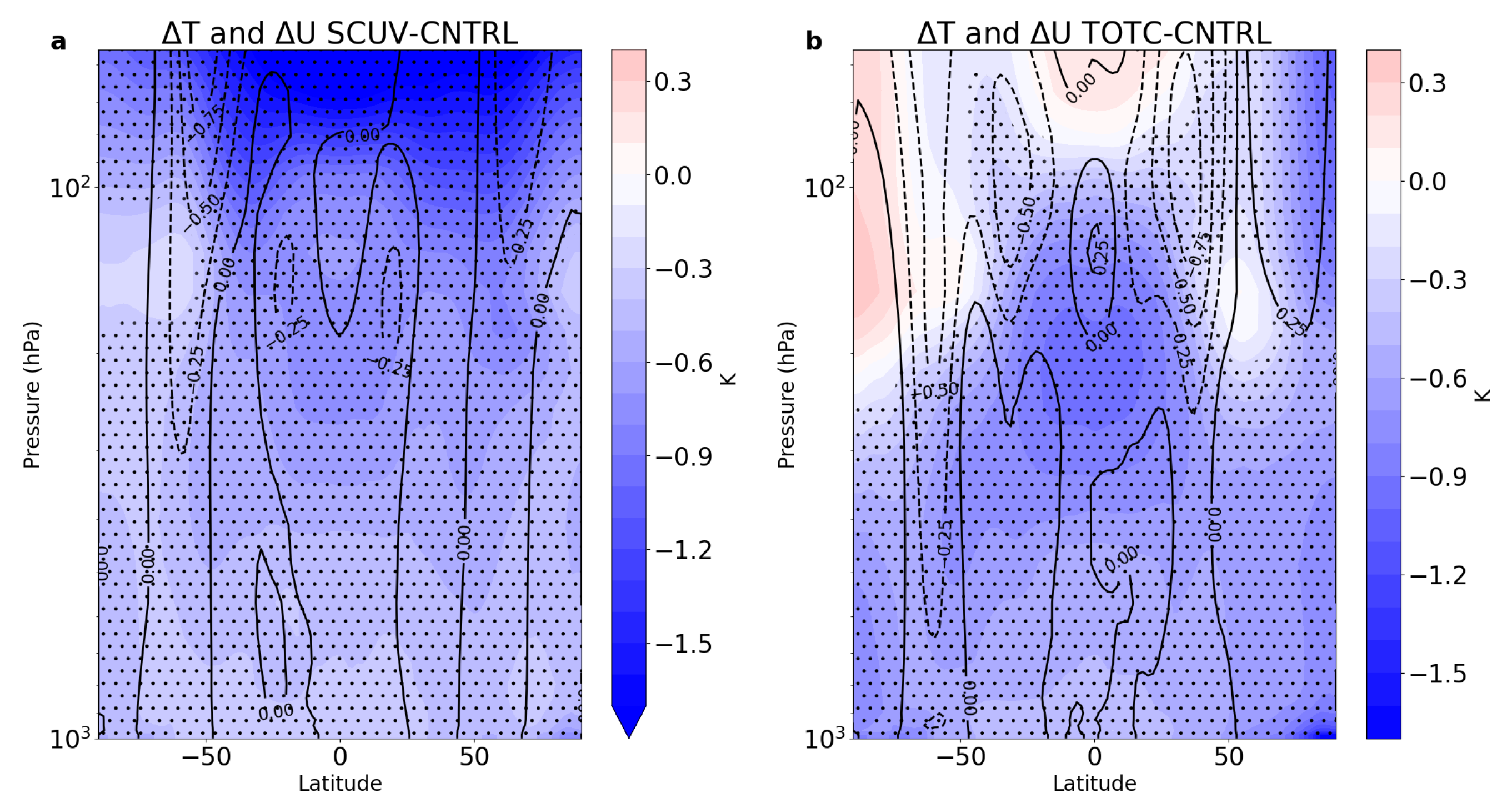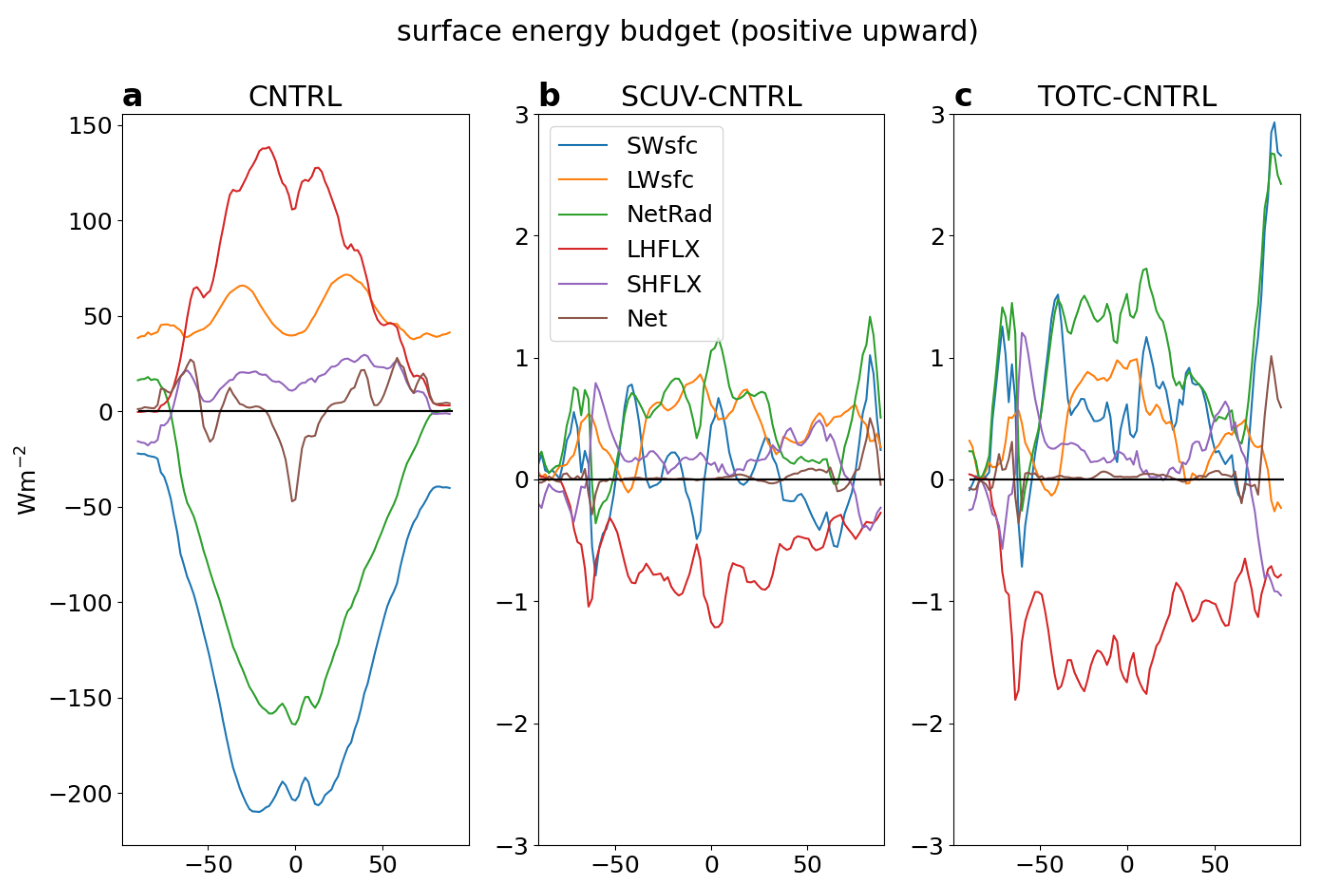Equilibrium Climate after Spectral and Bolometric Irradiance Reduction in Grand Solar Minimum Simulations
Abstract
:1. Introduction
2. Methods
3. Results
3.1. Tropospheric and Stratospheric Response
3.2. Radiative and Dynamical Heating Rates
3.3. Atmospheric Circulation, Heat Transport and Radiative Feedbacks
4. Conclusions
- TOTC receives lower values of incoming radiation at the surface than SCUV. In TOTC, there is an absolute minimum MHT difference in the NH tropical region, suggesting that tropical regions not only receive less heat but are also unable to transport it poleward, even though, in this experiment, there is a higher thermal gradient caused by strong polar cooling. MHT differences are small but significant. The low values of MHT differences between SCUV, TOTC and CNTRL do not come as a surprise. Ref. [65] showed that MHT is nearly invariant in an ensemble of experiments spanning from the last glaciation to a world with CO2 quadrupled above the pre-industrial situation.
- The difference in cloudiness among the experiments shows that the presence of feedback may also change the differential response. SCUV shows many more high clouds that reduce absorbed shortwave radiation by increasing the planetary albedo, as also shown by [71]. At the same time, they may contribute to warming the planet, whereas TOTC has more low clouds, which have a cooling effect on the climate as they increase outgoing longwave radiation. Low clouds over SH oceans would also play a role in the teleconnection between mid-latitudes and the tropical region [70];
- TOTC exhibits polar amplification in the Arctic region that cools the planet because of more ice fraction compared to CNTRL and SCUV. This larger cooling of the NH has consequences for the tropics as the HC and ITCZ are, in some way, correlated with cross-equatorial energy transport.
Supplementary Materials
Author Contributions
Funding
Data Availability Statement
Acknowledgments
Conflicts of Interest
Abbreviations
| ASR | Absorbed Solar Radiation |
| ANN | Annual |
| CLDLOW | Low Clouds |
| CNTRL | Control Experiment |
| DJF | December–January–February |
| DTCORE | Dynamical Heating Rate |
| EP | Eliassen Palm |
| F | Flux |
| FDR | False Discovery Rate |
| GSM | Grand Solar Minim |
| ITCZ | Inter-tropical Convergence Zone |
| JJA | June–July–August |
| HC | Hadley Cell |
| LHFLX | Latent Heat Flux |
| LW | Longwave |
| MAM | March–April–May |
| MM | Maunder Minimum |
| MSE | Moist Static Energy |
| MHT | Meridional Heat Transport |
| NH | Northern Hemisphere |
| OLR | Outgoing Longwave Radiation |
| PRECT | Total Precipitation |
| QRL | Heating Rate of Longwave Radiation |
| QRS | Heating Rate of Shortwave Radiation |
| RTOA | Radiation at the Top of the Atmosphere |
| SH | Southern Hemisphere |
| SW | Shortwave |
| LHFLX | Sensible Heat Flux |
| SCUV | Experiment where the reduction is applied mainly to the ultraviolet spectrum |
| SOM | Slab Ocean Model |
| SON | September–October–November |
| SSI | Solar Spectral Irradiance |
| SST | Sea Surface Temperature |
| T | Temperature |
| TOA | Top of the atmosphere |
| TOTC | Experiment where the reduction is applied to all the radiation spectrum |
| TREFHT | 2 m Temperature |
| TSI | Total Solar Irradiation |
| U | Zonal Component of wind |
| UV | Ultra-violet |
| V | Meridional Component of Wind |
References
- Lean, J. Evolution of the Sun’s Spectral Irradiance since the Maunder Minimum. Geophys. Res. Lett. 2000, 27, 2425. [Google Scholar] [CrossRef]
- Unruh, Y.C.; Solanki, S.K.; Fligge, M. Modelling solar irradiance variations: Comparison with observations, including line-ratio variations. In Workshop of the ISSI on Solar Variability and Climate; Springer: Berlin/Heidelberg, Germany, 2000; pp. 145–152. ISSN 0038-6308. [Google Scholar]
- Woods, T.N.; Rottman, G.J. Solar ultraviolet variability over time periods of aeronomic interest. In Comparative Aeronomy in the Solar System; Mendillo, M., Nagy, A., Waite, J., Eds.; American Geophysical Union: Washington, DC, USA, 2002; Volume 130, pp. 221–233. [Google Scholar]
- Lockwood, M. Was UV spectral solar irradiance lower during the recent low sunspot minimum? J. Geophys. Res. 2011, 116, D16103. [Google Scholar] [CrossRef]
- Woods, T.N.; Snow, M.; Harder, J.; Chapman, G.; Cookson, A. A different view of solar spectral irradiance variations: Modeling total energy of six-month intervals. Sol. Phys. 2015, 290, 2649. [Google Scholar] [CrossRef]
- Coddington, O.; Lean, J.; Pilewskie, P.; Snow, M.; Richard, E.; Kopp, G.; Lindholm, C.; DeLand, M.; Marchenko, S.; Haberreiter, M.; et al. Solar Irradiance variability: Comparisons of models and measurements. Earth Space Sci. 2019, 6, 2525–2555. [Google Scholar] [CrossRef]
- Krivova, N.A.; Solanki, S.K. Reconstruction of solar UV irradiance since 1974. Adv. Space Res. 2009, 114, D00I04. [Google Scholar] [CrossRef]
- Shapiro, A.I.; Schmutz, W.; Rozanov, E.; Schoell, M.; Haberreiter, M.; Shapiro, A.V.; Nyeki, S. A new approach to the long-term reconstruction of the solar irradiance leads to large historical solar forcing. Astron. Astrophys. 2011, 539, A67. [Google Scholar] [CrossRef]
- Schmidt, G.A.; Jungclaus, J.H.; Ammann, C.M.; Bard, E.; Braconnot, P.; Crowley, T.J.; Delaygue, G.; Joos, F.; Krivova, N.A.; Muscheler, R.; et al. Climate forcing reconstructions for use in PMIP simulations of the Last Millennium (v1.1). Geosci. Model Dev. 2012, 5, 185–191. [Google Scholar] [CrossRef]
- Lubin, D.; Miles, C.; Tytler, D. Ultraviolet flux decrease under a Grand Minimum from IUE Short-wavelength observation of solar analogs. Astron. Astrophys. 2017, 852, L4. [Google Scholar] [CrossRef]
- Wu, C.J.; Krivova, N.A.; Solanki, S.A.; Usoskin, I.G. Solar total and spectral irradiance reconstruction over the last 9000 years. Astron. Astrophys. 2018, 620, A120. [Google Scholar] [CrossRef]
- Mörner, N. The Approaching New Grand Solar Minimum and Little Ice Age Climate Conditions. Nat. Sci. 2015, 7, 510–518. [Google Scholar] [CrossRef]
- Luterbacher, J.; Rickli, R.; Xoplaki, E.; Tinguely, C.; Beck, C.; Pfister, C.; Wanner, H. The Late Maunder Minimum (1675–1715)—A key period for studying decadal scale climatic change in Europe. Clim. Chang. 2001, 49, 441–462. [Google Scholar] [CrossRef]
- Vaquero, J.M.; Svalgaard, L.; Carrasco, V.M.S.; Clette, F.; Lefévre, L.; Gallego, M.C.; Arlt, R.; Aparicio, A.J.P.; Richard, J.G.; Howe, R. A revised collection of sunspot group numbers. Sol. Phys. 2016, 91, 3061–3074. [Google Scholar] [CrossRef]
- Lehner, F.; Joos, F.; Raible, C.C.; Mignot, J.; Born, A.; Keller, K.M.; Stocker, T.F. Climate and carbon cycle dynamics in a CESM simulation from 850 to 2100 CE. Earth Syst. Dyn. 2015, 6, 411–434. [Google Scholar] [CrossRef]
- Velasco Herrera, V.M.; Mendoza, B.; Velasco Herrera, G. Reconstruction and Prediction of the Total Solar Irradiance; from the Medieval Warm Period to the 21st Century. New Astron. 2015, 34, 221–233. [Google Scholar] [CrossRef]
- Xoplaki, E.; Luterbacher, J.; Paeth, H.; Dietrich, D.; Steiner, N.; Grosjean, M.; Wanner, H. European spring and autumn temperature variability and change of extremes over the last half millennium. Geophys. Res. Lett. 2005, 32, L15713. [Google Scholar] [CrossRef]
- Christiansen, B.; Ljungqvist, F.C. The extra-tropical Northern Hemisphere temperature in the last two millennia: Reconstructions of low-frequency variability. Clim. Past 2012, 8, 765–786. [Google Scholar] [CrossRef]
- Wanner, H.; Pfister, C.; Brázdil, R.; Frich, P.; Frydendahl, K.; Jónsson, T.; Kington, J.; Lamb, H.H.; Rosenørn, S.; Wishman, E. Wintertime European circulation patterns during the Late Maunder Minimum cooling period (1675–1704). Theor. Appl. Climatol. 1995, 51, 167–175. [Google Scholar] [CrossRef]
- Barriopedro, D.; García-Herrera, R.; Huth, R. Solar modulation of Northern Hemisphere winter blocking. J. Geophys. Res. Atmos. 2008, 113, D14118. [Google Scholar] [CrossRef]
- Mellado-Cano, J.; Barriopedro, D.; García-Herrera, R.; Trigo, R.M.; Alvarez-Castro, M.C. Euro–Atlantic atmospheric circulation during the Late Maunder Minimum. J. Clim. 2018, 31, 3849–3863. [Google Scholar] [CrossRef]
- Foukal, P.; Ortiz, A.; Schnerr, R. Dimming of the 17th century sun. Astrophys. J. Lett. 2011, 733, L38. [Google Scholar] [CrossRef]
- Judge, P.G.; Lockwood, G.W.; Radick, R.R.; Henry, G.W.; Shapiro, A.I.; Schmutz, W.K.; Lindsey, C. Confronting a solar irradiance reconstruction with solar and stellar data. Astron. Astrophys. 2012, 544, A88. [Google Scholar] [CrossRef]
- Feulner, G.; Rahmstorf, S. On the effect of a new grand minimum of solar activity on the future climate on Earth. Geophys. Res. Lett. 2010, 37, L05707. [Google Scholar] [CrossRef]
- Abreu, J.A.; Beer, J.; Steinhilber, F.; Tobias, S.M.; Weiss, N.O. For how long will the current grand maximum of solar activity persist? Geophys. Res. Lett. 2008, 37, L20109. [Google Scholar] [CrossRef]
- Lockwood, M. Solar change and climate: An update in the light of the current exceptional solar minimum. Proc. R. Soc. A Math. Phys. Eng. Sci. 2010, 466, 303–329. [Google Scholar] [CrossRef]
- Egorova, T.; Schmutz, W.; Rozanov, E.; Shapiro, A.I.; Usoskin, I.; Beer, J.; Tagirov, R.V.; Peter, T. Revised historical solar irradiance forcing. Astron. Astrophys. 2018, 615, A85. [Google Scholar] [CrossRef]
- Krivova, N.A.; Solanki, S.K. Modelling of irradiance variations through atmosphere models. Mem. Soc. Astron. Ital. 2005, 76, 834–841. [Google Scholar]
- Lorenz, E.N. Forced and free variations of weather and climate. J. Atmos. Sci. 1979, 36, 1367–1376. [Google Scholar] [CrossRef]
- Haigh, J.D. A GCM study of climate change in response to the 11-year solar cycle. Q. J. R. Meteorol. Soc. 1999, 125, 871–892. [Google Scholar] [CrossRef]
- Meehl, G.A.; Arblaster, J.M.; Matthes, K.; Sassi, F.; van Loon, H. Amplifying the pacific climate system response to a small 11 year solar cycle forcing. Science 2009, 325, 1114–1118. [Google Scholar] [CrossRef]
- Gray, L.J.; Beer, J.; Geller, M.; Haigh, J.D.; Lockwood, M.; Matthes, K.; Cubasch, U.; Fleitmann, D.; Harrison, G.; Hood, L. Solar influences on climate. Rev. Geophys. 2010, 48, RG4001. [Google Scholar] [CrossRef]
- Kodera, K.; Kuroda, Y. Dynamical response to the solar cycle. J. Geophys. Res. Atmos. 2002, 107, ACL 5-1–ACL 5-12. [Google Scholar] [CrossRef]
- Haigh, J.D. The role of stratospheric ozone in modulating the solar radiative forcing of climate. Nature 1994, 370, 544–546. [Google Scholar] [CrossRef]
- Misios, S.; Mitchell, D.M.; Gray, L.J.; Tourpali, K.; Matthes, K.; Hood, L.; Schmidt, H.; Chiodo, G.; Thiéblemont, R.; Rozanov, E.; et al. Solar signals in CMIP-5 simulations: Effects of atmosphere-ocean coupling. Q. J. R. Meteorol. Soc. 2015, 142, 928–941. [Google Scholar] [CrossRef]
- Shindell, D.T.; Schmidt, G.A.; Mann, M.E.; Rind, D.; Waple, A. Solar forcing of regional climate change during the Maunder minimum. Science 2001, 294, 2149. [Google Scholar] [CrossRef] [PubMed]
- Scaife, A.A.; Ineson, S.; Knight, J.R.; Gray, L.J.; Kodera, K.; Smith, D.M. A mechanism for lagged North Atlantic climate response to solar variability. Geophys. Res. Lett. 2013, 40, 434–439. [Google Scholar] [CrossRef]
- Andrews, M.B.; Knight, J.R.; Gray, L.J. A simulated lagged response of the North Atlantic Oscillation to the solar cycle over the period 1960–2009. Environ. Res. Lett. 2015, 10, 054022. [Google Scholar] [CrossRef]
- Guttu, S.; Orsolini, Y.; Stordal, F.; Otterå, O.H.; Omrani, N.-E.; Tartaglione, N.; Verronen, P.T.; Rodger, C.J.; Clilverd, M.A. Impacts of UV Irradiance and Medium-Energy Electron Precipitation on the North Atlantic Oscillation during the 11-Year Solar Cycle. Atmosphere 2021, 21, 1029. [Google Scholar] [CrossRef]
- Anet, J.G.; Rozanov, E.V.; Muthers, S.; Peter, T.; Brönnimann, S.; Arfeuille, F.; Beer, J.; Shapiro, A.I.; Raible, C.C.; Steinhilber, F.; et al. Impact of a potential 21st century “grand solar minimum” on surface temperatures and stratospheric ozone. Geophys. Res. Lett. 2013, 40, 4420–4425. [Google Scholar] [CrossRef]
- Chiodo, G.; Garcia-Herrera, R.; Calvo, N.; Vaquero, J.M.; Anel, J.A.; Barriopedro, D.; Matthes, K. The impact of a future solar minimum on climate change projections in the Northern Hemisphere. Environ. Res. Lett. 2016, 11, 034015. [Google Scholar] [CrossRef]
- Jones, G.S.; Lockwood, M.; Stott, P.A. What influence will future solar activity changes over the 21st century have on projected global near-surface temperature changes? J. Geophys. Res. Atmos. 2012, 117, D05103. [Google Scholar] [CrossRef]
- Maycock, A.C.; Ineson, S.; Gray, L.J.; Scaife, A.A.; Anstey, J.A.; Lockwood, M.; Butchart, N.; Hardiman, S.C.; Mitchell, D.M.; Osprey, S.M. Possible impacts of a future grand solar minimum on climate: Stratospheric and global circulation changes. J. Geophys. Res. Atmos. 2015, 120, 9043–9058. [Google Scholar] [CrossRef] [PubMed]
- Meehl, G.A.; Arblaster, J.M.; Marsh, D.R. Could a future grand solar minimum like the maunder minimum stop global warming? Geophys. Res. Lett. 2013, 40, 1789–1793. [Google Scholar] [CrossRef]
- Ineson, S.; Maycock, A.C.; Gray, L.J.; Scaife, A.A.; Dunstone, N.J.; Harder, J.W.; Knight, J.R.; Lockwood, M.; Manners, J.C.; Wood, R.A. Regional climate impacts of a possible future grand solar minimum. Nat. Commun. 2015, 6, 7535. [Google Scholar] [CrossRef] [PubMed]
- Anet, J.G.; Muthers, S.; Rozanov, E.V.; Raible, C.C.; Stenke, A.; Shapiro, A.I.; Brönnimann, S.; Arfeuille, F.; Brugnara, Y.; Beer, J.; et al. Impact of solar versus volcanic activity variations on tropospheric temperatures and precipitation during the Dalton Minimum. Clim. Past 2014, 10, 921–938. [Google Scholar] [CrossRef]
- Arsenovic, P.; Rozanov, E.; Anet, J.; Stenke, A.; Schmutz, W.; Peter, T. Implications of potential future grand solar minimum for ozone layer and climate. Atmos. Chem. Phys. 2013, 18, 3469–3483. [Google Scholar] [CrossRef]
- Anet, J.G.; Muthers, S.; Rozanov, E.; Raible, C.C.; Peter, T.; Stenke, A.; Shapiro, A.I.; Beer, J.; Steinhilber, F.; Brönnimann, S.; et al. Forcing of stratospheric chemistry and dynamics during the Dalton Minimum. Atmos. Chem. Phys. 2013, 13, 10951–10967. [Google Scholar] [CrossRef]
- Rind, D.; Shindell, D.; Perlwitz, J.; Lerner, J.; Lonergan, P.; Lean, J.; McLinden, C. The relative importance of solar and anthropogenic forcing of climate change between the Maunder Minimum and the present. J. Clim. 2004, 17, 906–929. [Google Scholar] [CrossRef]
- Neale, R.B.; Chen, C.C.; Gettelman, A.; Lauritzen, P.H.; Park, S.; Williamson, D.L.; Conley, A.J.; Garcia, R.; Kinnison, D.; Lamarque, J.F.; et al. Description of the NCAR Community Atmosphere Model (CAM5); NCAR Tech. Note NCAR/TN-486+ STR; National Center for Atmospheric Research: Boulder, CO, USA, 2012. [Google Scholar]
- Marsh, D.R.; Mills, M.; Kinnison, D.; Lamarque, J.-F.; Calvo, N.; Polvani, L. Climate change from 1850 to 2005 simulated in CESM1(WACCM). J. Clim. 2013, 26, 7372–7391. [Google Scholar] [CrossRef]
- Marsh, D.R.; Garcia, R.R.; Kinnison, D.E.; Boville, B.A.; Sassi, F.; Solomon, S.C.; Matthes, K. Modeling the whole atmosphere response to solar cycle changes in radiative and geomagnetic forcing. J. Geophys. Res. Atmos. 2013, 112, 1–20. [Google Scholar] [CrossRef]
- Thiéblemont, R.; Matthes, K.; Omrani, N.-E.; Kodera, K.; Hansen, F. Solar forcing synchronizes decadal North Atlantic climate variability. Nat. Commun. 2015, 6, 8268. [Google Scholar] [CrossRef]
- Tartaglione, N.; Toniazzo, T.; Orsolini, Y.; Otterå, O.H. Impact of solar irradiance and geomagnetic activity on polar NOx ozone and temperature in WACCM simulations. J. Atmos. Sol. Terr. Phys. 2020, 209, 105398. [Google Scholar] [CrossRef]
- Schrijver, C.J.; Livingston, W.C.; Woods, T.N.; Mewaldt, R.A. The minimal solar activity in 2008–2009 and its implications for long-term climate modeling. Geophys. Res. Lett. 2011, 38, L06701. [Google Scholar] [CrossRef]
- Roth, R.; Joos, F. A reconstruction of radiocarbon production and total solar irradiance from the Holocene 14C and CO2 records: Implications of data and model uncertainties. Clim. Past 2013, 9, 1879–1909. [Google Scholar] [CrossRef]
- Lean, J.; Beer, J.; Bradley, R. Reconstruction of solar irradiance since 1610: Implications for climate change. Geophys. Res. Lett. 1995, 22, 3195–3198. [Google Scholar] [CrossRef]
- Lean, J.L. Estimating solar irradiance since 850 CE. Earth Space Sci. 2018, 5, 133–149. [Google Scholar] [CrossRef]
- Feulner, G. Are the most recent estimates for Maunder Minimum solar irradiance in agreement with temperature reconstructions? Geophys. Res. Lett. 2011, 38, L16706. [Google Scholar] [CrossRef]
- Peck, E.D.; Randall, C.E.; Harvey, V.L.; Marsh, D.R. Simulated solar cycle effects on the middle atmosphere: WACCM3 versus WACCM4. J. Adv. Model. Earth Syst. 2015, 7, 806–822. [Google Scholar] [CrossRef]
- Wilks, D.S. The stippling shows statistically significant grid-points. How research results are routinely overstated and overinterpreted, and what to do about it. Bull. Am. Meteorol. Soc. 2016, 97, 2263–2273. [Google Scholar] [CrossRef]
- Tartaglione, N.; Toniazzo, T.; Orsolini, Y.; Otterå, O.H. A note on the statistical evidence for an influence of geomagnetic activity on Northern Hemisphere seasonal-mean stratospheric temperatures using the Japanese 55-year Reanalysis. Ann. Geophys. 2020, 38, 545–555. [Google Scholar] [CrossRef]
- Kodera, K.; Thiéblemont, R.; Yukimoto, S.; Matthes, K. How can we understand the global distribution of the solar cycle signal on the Earth’s surface? Atmos. Chem. Phys. 2016, 16, 12925–12944. [Google Scholar] [CrossRef]
- Rao, J.; Yu, Y.Y.; Guo, D.; Shi, C.H.; Chen, D.; Hu, D.Z. Evaluating the Brewer–Dobson circulation and its responses to ENSO, QBO, and the solar cycle in different reanalyses. Earth Planet. Sci. 2019, 3, 166–181. [Google Scholar] [CrossRef]
- Donohoe, A.; Armour, K.C.; Roe, G.H.; Battisti, D.S.; Hahn, L. The Partitioning of Meridional Heat Transport from the Last Glacial Maximum to CO2 Quadrupling in Coupled Climate Models. J. Clim. 2020, 33, 4141–4165. [Google Scholar] [CrossRef]
- Kang, S.M.; Hawcroft, M.; Xiang, B.; Hwang, Y.-T.; Cazes, G.; Codron, F.; Crueger, T.; Deser, C.; Hodnebrog, Ø.; Kim, H.; et al. Extratropical–Tropical Interaction Model Intercomparison Project (Etin-Mip): Protocol and Initial Results. Bull. Am. Meteorol. Soc. 2019, 100, 2589–2606. [Google Scholar] [CrossRef]
- Hwang, Y.; Tseng, H.; Li, K.; Kang, S.M.; Chen, Y.; Chiang, J.C.H. Relative roles of energy and momentum fluxes in the tropical response to extratropical thermal forcing. J. Clim. 2021, 34, 3771–3786. [Google Scholar] [CrossRef]
- Feldl, N.; Bordoni, S. Characterizing the Hadley circulation response through regional climate feedbacks. J. Clim. 2016, 29, 613–622. [Google Scholar] [CrossRef]
- Kang, S.M.; Xie, S.-P.; Shin, Y.; Kim, H.; Hwang, Y.-T.; Stuecker, M.F.; Xiang, B.; Hawcroft, A.M. Walker circulation response to extratropical radiative forcing. Sci. Adv. 2020, 6, eabd3021. [Google Scholar] [CrossRef]
- Dong, Y.; Armour, K.C.; Battisti, D.S.; Blanchard-Wrigglesworth, E. Two-Way Teleconnections between the Southern Ocean and the Tropical Pacific via a Dynamic Feedback. J. Clim. 2022, 35, 6267–6282. [Google Scholar] [CrossRef]
- Donohoe, A.; Battisti, D.S. Atmospheric and Surface Contributions to Planetary Albedo. J. Clim. 2011, 24, 4402–4418. [Google Scholar] [CrossRef]
- Shindell, D.T.; Faluvegi, G.; Schmidt, G.A. Influences of solar forcing at ultraviolet and longer wavelengths on climate. J. Geophys. Res. Atmos. 2020, 124, e2019JD031640. [Google Scholar] [CrossRef]
- Connolly, R.; Soon, W.; Connolly, M.; Baliunas, S.; Berglund, J.; Butler, C.J.; Cionco, R.G.; Elias, A.G.; Fedorov, V.M.; Harde, H.; et al. How much has the Sun influenced Northern Hemisphere temperature trends? An ongoing debate. Res. Astron. Astrophys. 2021, 21, 131. [Google Scholar] [CrossRef]
- Jardine, P.E.; Fraser, W.T.; Gosling, W.D.; Roberts, C.N.; Eastwood, W.J.; Lomax, B.H. Proxy reconstruction of ultraviolet-B irradiance at the Earth’s surface, and its relationship with solar activity and ozone thickness. Holocene 2010, 30, 155–161. [Google Scholar] [CrossRef]












Disclaimer/Publisher’s Note: The statements, opinions and data contained in all publications are solely those of the individual author(s) and contributor(s) and not of MDPI and/or the editor(s). MDPI and/or the editor(s) disclaim responsibility for any injury to people or property resulting from any ideas, methods, instructions or products referred to in the content. |
© 2023 by the authors. Licensee MDPI, Basel, Switzerland. This article is an open access article distributed under the terms and conditions of the Creative Commons Attribution (CC BY) license (https://creativecommons.org/licenses/by/4.0/).
Share and Cite
Tartaglione, N.; Toniazzo, T.; Otterå, O.H.; Orsolini, Y. Equilibrium Climate after Spectral and Bolometric Irradiance Reduction in Grand Solar Minimum Simulations. Climate 2024, 12, 1. https://doi.org/10.3390/cli12010001
Tartaglione N, Toniazzo T, Otterå OH, Orsolini Y. Equilibrium Climate after Spectral and Bolometric Irradiance Reduction in Grand Solar Minimum Simulations. Climate. 2024; 12(1):1. https://doi.org/10.3390/cli12010001
Chicago/Turabian StyleTartaglione, Nazario, Thomas Toniazzo, Odd Helge Otterå, and Yvan Orsolini. 2024. "Equilibrium Climate after Spectral and Bolometric Irradiance Reduction in Grand Solar Minimum Simulations" Climate 12, no. 1: 1. https://doi.org/10.3390/cli12010001
APA StyleTartaglione, N., Toniazzo, T., Otterå, O. H., & Orsolini, Y. (2024). Equilibrium Climate after Spectral and Bolometric Irradiance Reduction in Grand Solar Minimum Simulations. Climate, 12(1), 1. https://doi.org/10.3390/cli12010001





